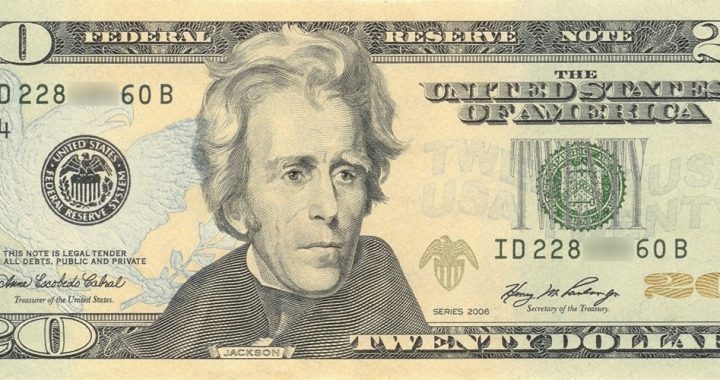
On January 8, 1815, leading a rag-tag army composed of frontier militia, pirates, and allied Indians, Andrew Jackson defeated the British army at the Battle of New Orleans — an army that had just defeated Napoleon at the Battle of the Nations. This huge and important win made the name of Andrew Jackson almost universally known and admired in the United States, and eventually propelled him into the White House as our seventh president.
In 1961, Johnny Horton’s song, “The Battle of New Orleans” topped the music charts for weeks.
Yet, this same Andrew Jackson is now reviled by the “politically correct” crowd and cast as a man of almost unbelievable evil. The image now perpetuated in the popular American culture, the media, and in academia is more like a comic book villain rather than a real flesh-and-blood human being with many flaws — and many heroic features.
United States Senator James Lankford (R-Okla.) has even introduced legislation to remove the portrait of Andrew Jackson from the $20 Federal Reserve Note. Lankford’s bill would also require the Treasury Department select a woman to replace Jackson, although he did not specify who that woman would be.
Apparently, Lankford is challenging the decision of the Treasury Department to dump Alexander Hamilton, the first treasury secretary, off the $10 Federal Reserve Note, also with the intention of putting a woman’s portrait on the bill.
“If we’re going to replace anyone on a bill, Andrew Jackson should be first in line,” Lankford told a reporter for the Oklahoman newspaper.
Lankford’s bill states, “Forced removal by Andrew Jackson of American Indians and the subsequent inhumane settlement of Indians lands represent a major blight on the proud history of the United States.”
While much of the population of Oklahoma, the state Lankford represents in the Senate, has some Indian blood, Lankford was born and raised in Texas. He told a reporter that he first learned about the Indian removal in his college history course. Exactly why Lankford was uninformed about this major event in American history until he got to college is not clear, but it certainly was not because the American history textbooks used in Texas did not cover it. All of them did.
A fellow Republican member of the Oklahoma congressional delegation, Congressman Tom Cole, who is part Chickasaw Indian, supported Lankford’s effort to remove Jackson from the $20 note, but said, “If we’re going to do it, we shouldn’t do it for reasons of political correctness.” This is an amazing statement from Cole, who has devoted a fair amount of his time to getting the Washington Redskins to drop their name.
Cole admitted he has “a very prejudiced view” of Jackson, noting that his grandmother would not even carry a $20 bill.
The Oklahoman article, written by their Washington Bureau’s Chris Casteel, said that “Jackson ordered the removal of the Chickasaws and other Indian tribes from their longtime homes in southern U.S. states to Indian Territory, what would later become Oklahoma.”
This action is certainly deplorable, but it should be noted that Jackson did not act in the manner of many recent U.S. presidents, particularly Barack Obama, and issue executive orders, without supporting legislation from Congress, as one might infer from the story. Congress passed the Indian Resettlement Act in 1830, which authorized the executive branch to negotiate with various Indian tribes to sell their land and receive lands in exchange in Indian Territory west of the Mississippi River. The treaties eventually signed with the various tribal governments were ratified by the U.S. Senate, with overwhelming support of the American public.
Anyone studying the history of the negotiations and subsequent removals of the Indian tribes would conclude that it was obvious the U.S. government was not going to take no for an answer. While the removals were technically effected following the signing and ratification of treaties, they were hardly something the Indians desired.
But the modern narrative that Jackson got this done all by himself, and should bear all of the blame, is, at best, an incomplete picture of the situation. Congress supported Jackson’s actions, and he was backed by a huge majority of the American people. If we are going to erase the other positive contributions of Andrew Jackson to American history because of this, then it would only seem fair to spread the blame to Congress — and to the people themselves, alive at the time. And Jackson was not even president for all of the removals. The infamous Cherokee removals were accomplished during the time of Jackson’s successor, Martin Van Buren.
The Indian removal is an indefensible policy, but Jackson’s role should be placed in some perspective. First of all, Jackson did not originate the idea of moving the Indians west of the Mississippi River. After Thomas Jefferson and Congress purchased the Louisiana Territory from the French in 1803, Jefferson told many Native American tribal chiefs that he believed it would be in their best interest to move west. He added that it should be strictly voluntary.
Jefferson was troubled by continued westward expansion, which was causing destruction of the Indian’s tribes and culture. As farms moved westward, forest lands, so important to the economy of the tribes, were, if not disappearing, at least diminishing.
After Jefferson, others, notably Secretary of War John C. Calhoun, advocated Indian removal. Had public opinion polls been conducted at the time, there is little question that removal would have gotten strong majority support — whether that removal was effected through voluntary or involuntary means.
As Americans pushed up against, and even into, Indian lands, pressure was brought for the government to purchase more and more land from the indigenous tribes. With increasing reluctance, tribes signed away land, with promises that the government would keep white settlers from trespassing on the remaining Indian land.
Jackson, a military man, saw firsthand the difficulty in enforcing these promises. Before he removed the Indians, he removed whites — from Indian lands. But they kept coming back anyway. Any president who actually cracked down on settlers violating tribal sovereignty would face the settlers’ wrath at the polls. These poor settlers may not have had much money, but they did have the vote. And they weren’t afraid to use it.
Assimilation was offered as an alternative solution to the problem, but it was not very popular with either the tribes or white Americans. Generally speaking, most Indians did not wish to “assimilate,” and most poor white settlers did not want the Indians to “assimilate,” either. They just wanted their land.
By the time Jackson won the presidential election in 1828, it was clear that either Jackson would remove the Indians in the east, or the people would elect a different president who would accomplish the removal of the Indians.
Jackson’s removal of the Indians is certainly a blot on his reputation. But, if we are going to delete every person off the currency who has flaws, Federal Reserve Notes would have no portraits. Certainly, Abraham Lincoln, whose face graces the $5 bill, committed wholesale violations of civil liberties during the Civil War, as did Ulysses S. Grant, found on the $50 bill.
But to say that Jackson is not alone in having done some things wrong is not an argument for keeping him on the $20 bill.
Did Jackson do anything positive?
Two men are on the currency who were not presidents, both of which played significant roles in American history. Benjamin Franklin, on the $100 bill, was a significant member of both the Continental Congress, having served on the committee to draft the Declaration of Independence, and the Constitutional Convention. His other achievements are too numerous to mention. And Alexander Hamilton, whom we find on the $10 bill, not only served as the first secretary of the treasury, but he basically created the monetary system of the country. Removal of Hamilton simply to put a woman — any woman, just so long as it is a woman — on the bill is the very essence of political correctness.
How does Jackson stack up with these men, and the “father of our country,” George Washington, who is on the $1 bill. Certainly, no one can compare with Washington, and an argument could be made that his is the only portrait that should appear on any American currency.
But, Jackson does have very significant achievements. Had Jackson lost the Battle of New Orleans, that city might very well not be part of the United States today. Historical illiterates often comment that the battle was actually fought after the War of 1812 was over. Their contention is that the Treaty of Ghent, ending the war, was signed in Belgium several days before the battle. Such an assertion does not consider that the Treaty was as yet unratified by the British Parliament, and therefore not yet in effect. Had the British won at New Orleans, it is doubtful the Parliament would have ratified the Treaty of Ghent, and simply handed New Orleans back over to the United States. Despite the issue of the war having already been resolved, many in the British government were reluctant to make peace with the Americans, still smarting over the Americans making war on them while they were still fighting Napoleon.
Before Jackson became president, the Republican Party launched by Thomas Jefferson had drifted into adopting many of the policies of the rival Federalist Party, led by Alexander Hamilton. While Jefferson had begun his Republican Party to combat the nationalistic vision of Hamilton (especially Hamilton’s Bank of the United States, which Jefferson regarded as unconstitutional), it was Jefferson’s own Republican Party that had chartered a Second Bank of the United States in 1816.
This precipitated the launching of an “Old Republican” movement, designed to take the party back to its roots of support for constitutional government. It was led by such men as Congressman John Randolph of Roanoke, a cousin of Jefferson’s. Both men were particularly incensed at the creation of the Second Bank of the United States. The movement, however, needed a man who could attract enough popular support to regain control of the government.
That man was Andrew Jackson. His victory in 1828 led to a new two-party system, with the original Jefferson Republican Party breaking into a “Democratic Republican” Party led by Jackson, and a “National Republican” Party led by John Quincy Adams and Henry Clay. The Democratic Republicans soon became the Democrats and the National Republicans quickly became the Whigs.
In 1832, in an effort to defeat Jackson, Nicholas Biddle, the president of the Second Bank of the United States, brought up its 20-year charter for a renewal vote four years early. The Whigs thought if Jackson vetoed the measure, he would lose the election to Clay. If he signed it, then their central bank was safe for another 20 years.
Jackson vetoed the bill, leading to the eventual demise of America’s second central bank. In his veto message, he argued that the bank was an unconstitutional granting of a monopoly by Congress (as Jefferson had argued against Hamilton’s bank many years earlier). He believed it was an example of the wealthy and powerful elites using the power of the federal government to achieve an unfair advantage — much like the “crony capitalism” of today — and was a dangerous concentration of power in the hands of that powerful elite.
One hundred years after Jackson’s election, the U.S. Treasury put Jackson’s portrait on the $20 Federal Reserve Note. The Federal Reserve System had been established by Congress in 1913, and was, in effect, America’s third central bank. Some have even wondered if putting Jackson on a Federal Reserve Note was a little “joke” against the man who had once killed off central banking in the United States.
Certainly, Andrew Jackson did both good and bad as president, and we could list many examples of both. But Jackson’s victory over the British in 1815 and his killing of central banking in 1832 are certainly both great achievements. While there are other Americans who, it could be argued, have made even greater positive contributions to the country than Jackson and the others who are presently the faces of our currency, there certainly could not be many.
Perhaps a compromise is in order. Take Jackson off the $20 Federal Reserve Note, and abolish the Federal Reserve System itself. That is a compromise that “Old Hickory” himself would certainly approve!
Steve Byas is a professor of history at Hillsdale Free Will Baptist College in Moore, Oklahoma. His book, History’s Greatest Libels, is a defense of many unfairly attacked individuals in history, including Thomas Jefferson, Christopher Columbus, and Joseph McCarthy.



